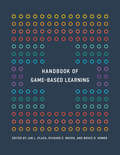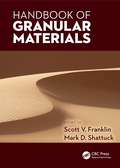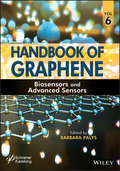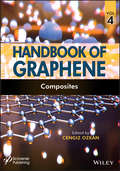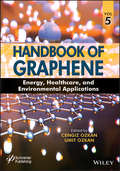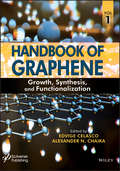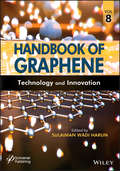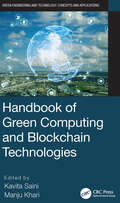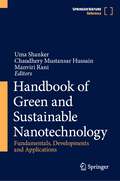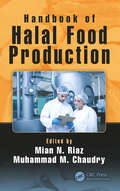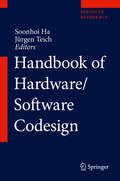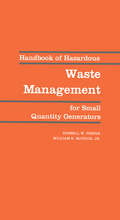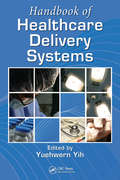- Table View
- List View
Handbook of Game-Based Learning (The\mit Press Ser.)
by Jan L. Plass Richard E. Mayer Bruce D. HomerA comprehensive introduction to the latest research and theory on learning and instruction with computer games.This book offers a comprehensive introduction to the latest research on learning and instruction with computer games. Unlike other books on the topic, which emphasize game development or best practices, Handbook of Game-Based Learning is based on empirical findings and grounded in psychological and learning sciences theory. The contributors, all leading researchers in the field, offer a range of perspectives, including cognitive, motivational, affective, and sociocultural. They explore research on whether (and how) computer games can help students learn educational content and academic skills; which game features (including feedback, incentives, adaptivity, narrative theme, and game mechanics) can improve the instructional effectiveness of these games; and applications, including games for learning in STEM disciplines, for training cognitive skills, for workforce learning, and for assessment. The Handbook offers an indispensable reference both for readers with practical interests in designing or selecting effective game-based learning environments and for scholars who conduct or evaluate research in the field. It can also be used in courses related to play, cognition, motivation, affect, instruction, and technology.ContributorsRoger Azevedo, Ryan S. Baker, Daphne Bavelier, Amanda E. Bradbury, Ruth C. Clark, Michele D. Dickey, Hamadi Henderson, Bruce D. Homer, Fengfeng Ke, Younsu Kim, Charles E. Kinzer, Eric Klopfer, James C. Lester, Kristina Loderer, Richard E. Mayer, Bradford W. Mott, Nicholas V. Mudrick, Brian Nelson, Frank Nguyen, V. Elizabeth Owen, Shashank Pawar, Reinhard Pekrun, Jan L. Plass, Charles Raffale, Jonathon Reinhardt, C. Scott Rigby, Jonathan P. Rowe, Richard M. Ryan, Ruth N. Schwartz, Quinnipiac Valerie J. Shute, Randall D. Spain, Constance Steinkuehler, Frankie Tam, Michelle Taub, Meredith Thompson, Steven L. Thorne, A. M. Tsaasan
Handbook of Gas Sensor Materials
by Ghenadii KorotcenkovThe two volumes of Handbook of Gas Sensor Materials provide a detailed and comprehensive account of materials for gas sensors, including the properties and relative advantages of various materials. Since these sensors can be applied for the automation of myriad industrial processes, as well as for everyday monitoring of such activities as public safety, engine performance, medical therapeutics, and in many other situations, this handbook is of great value. Gas sensor designers will find a treasure trove of material in these two books.
Handbook of Geophysical Exploration at Sea
by Richard A. Geyer Margaret AshwellThis two-volume handbook presents advanced research and operational information about hard minerals and hydrocarbons. It provides information in an integrated, interdisciplinary manner, stressing case histories. It includes review chapters, illustrations, graphs, tables, and color satellite images that present the results of gravity, geodetic, and seismic surveys and of 3-D sea floor sub-bottom visualizations. The data was obtained using satellites, aircraft, and ships from the Atlantic and Pacific Oceans, the Gulf of Mexico, and the Caribbean Sea. Major topics addressed in these volumes include geophysical methods used to explore for hydrocarbons, advanced radiometric and electrical methods for hard mineral searches, the role of geotechnology and seismic acoustics in overcoming geological hazards in selecting drilling sites and pipeline routes, and remote sensing techniques used to determine the physical properties of sediments.
Handbook of Geospatial Approaches to Sustainable Cities (Imaging Science)
by Qihao Weng Cheolhee YooThis comprehensive handbook presents the current state of knowledge on geospatial technologies, techniques, and methods that are imperative for providing solutions to sustainable cities. It addresses the role of geospatial big data and AI techniques and how they are applied when analyzing the sustainability of urban development, land use, urban planning, and resource management, as well as monitoring the impact urbanization has on the environment and the ecosystem. Taking an interdisciplinary approach to sustainable cities, and with contributions from renowned experts around the world, this holistic handbook is a toolbox for geospatial, urban, and sustainability professionals, the artificial intelligence community, and those who work in related fields.Features: Explores cutting-edge geospatial and AI techniques in support of efficient, resilient, digital, and smart cities Bridges urban science and sustainability science via geospatial methods Contributes to the efforts of GEO by addressing and exemplifying pertinent societal benefit areas and engagement priorities Includes 16 case studies with a broad geographic scope that integrate societal needs with technological advances Draws expertise in geospatial technology, big data, and artificial intelligence from leading experts in the world This book is intended for researchers and scientists interested in learning techniques in GeoAI, including the technologies for collecting, analyzing, managing, processing, and visualizing geospatial datasets. Chapters 3, 6, 7, 8, and 15 of this book are freely available as a downloadable Open Access PDF at http://www.taylorfrancis.com under a Creative Commons Attribution-Non Commercial-No Derivatives (CC BY-NC-ND) 4.0 license.
Handbook of Geospatial Artificial Intelligence
by Song Gao Yingjie Hu Wenwen LiThis comprehensive handbook covers Geospatial Artificial Intelligence (GeoAI), which is the integration of geospatial studies and AI machine (deep) learning and knowledge graph technologies. It explains key fundamental concepts, methods, models, and technologies of GeoAI, and discusses the recent advances, research tools, and applications that range from environmental observation and social sensing to natural disaster responses. As the first single volume on this fast-emerging domain, Handbook of Geospatial Artificial Intelligence is an excellent resource for educators, students, researchers, and practitioners utilizing GeoAI in fields such as information science, environment and natural resources, geosciences, and geography. Features Provides systematic introductions and discussions of GeoAI theory, methods, technologies, applications, and future perspectives Covers a wide range of GeoAI applications and case studies in practice Offers supplementary materials such as data, programming code, tools, and case studies Discusses the recent developments of GeoAI methods and tools Includes contributions written by top experts in cutting-edge GeoAI topics This book is intended for upper-level undergraduate and graduate students from different disciplines and those taking GIS courses in geography or computer sciences as well as software engineers, geospatial industry engineers, GIS professionals in non-governmental organizations, and federal/state agencies who use GIS and want to learn more about GeoAI advances and applications.
Handbook of Geotechnical Investigation and Design Tables: Second Edition
by Burt G. LookThis practical handbook of properties for soils and rock contains in a concise tabular format the key issues relevant to geotechnical investigations, assessments and designs in common practice. There are brief notes on the application of the tables. These data tables are compiled for experienced geotechnical professionals who require a reference do
Handbook of Geotechnical Testing: Basic Theory Procedures And Comparison Of Standards
by Yanrong LiDetermination of the physical, chemical and mechanical properties of ground materials is the key to successfully deliver such projects as slope stabilization, excavation and lateral support, foundation etc. A book containing both theory of geomaterial testing and up-to-date testing methods is much in demand for obtaining reliable and accurate test results. This book is intended primarily to serve this need and aims at the clear explanation, in adequate depth, of the fundamental principles, requirements and procedures of soil and rock tests. It is intended that the book will serve as a useful source of reference for professionals in the field of geotechnical and geological engineering. It can work as a one-stop knowledge warehouse to build a basic cognition of material tests on which the readers are working. It helps college students bridge the gap between class education and engineering practice, and helps academic researchers guarantee reliable and accurate test results. It is also useful for training new technicians and providing a refresher for veterans. Engineers contemplating the ICE, IOM3 and other certification exams will find this book an essential test preparation aid. It is assumed that the reader has no prior knowledge of the subject but has a good understanding of basic mechanics.
Handbook of Granular Materials
by Scott V. Franklin Mark D. ShattuckGranular systems arise in a variety of geological and industrial settings, from landslides, avalanches, and erosion to agricultural grains and pharmaceutical powders. Understanding the underlying physics that governs their behavior is the key to developing effective handling and transport mechanisms as well as appropriate environmental policies.Han
Handbook of Graphene: Biomaterials
by Sulaiman Wadi HarunThe seventh volume in a series of handbooks on graphene research and applicationsThe Handbook of Graphene, Volume 7: Biomaterials presents an overview of various graphene research initiatives and specific biomedical applications, where the properties of graphene are used differently. The book shares information on how graphene and graphene-based materials are utilized for the following types of applications: bio-targeting; medical and biomedical; drug delivery; antibacterial; and biological, biosensing and bioimaging. Topics covered include the role of graphene-based materials in: regenerative medicine; resistive memories and transistors; and implants in biomedicine. The impact of graphene-based biomaterials on biomedical applications is discussed, as are graphene-based systems in the delivery of therapeutics to the brain and central nervous system.
Handbook of Graphene: Biosensors and Advanced Sensors
by Barbara PalysThe sixth volume in a series of handbooks on graphene research and applicationsThe Handbook of Graphene, Volume 6: Biosensors and Advanced Sensors discusses the unique benefits that the discovery of graphene has brought to the sensing and biosensing sectors. It examines graphene's use in leading-edge technology applications and the development of a variety of graphene-based sensors. The handbook looks at how graphene can be used as an electrode, substrate, or transducer in sensor design. Graphene-based sensor detection has achieved up to femto-levels, with performances delivering the advantages of greater selectivity, sensitivity, and stability.
Handbook of Graphene: Composites
by Cengiz OzkanThe fourth volume in a series of handbooks on graphene research and applicationsThe Handbook of Graphene, Volume 4: Composites looks at composite materials exclusively. Topics covered include graphene composites and graphene-reinforced advanced composite materials. The following graphene-based subjects are discussed: ceramic composites; composite nanostructures; composites with shape memory effect; and scroll structures. Chapters also address: the fabrication and properties of copper–graphene composites; graphene–metal oxide composite as an anode material in li-ion batteries; supramolecular graphene-based systems for drug delivery; and other graphene-related areas of interest to scientists and researchers.
Handbook of Graphene: Energy, Healthcare, and Environmental Applications
by Cengiz Ozkan Umit S. OzkanThe fifth volume in a series of handbooks on graphene research and applicationsGraphene is a valuable nanomaterial used in technology. The Handbook of Graphene: Graphene in Energy, Healthcare, and Environmental Applications is the fifth volume in the handbook series. The book's topics include: graphene nanomaterials in energy and environment applications and graphene used as nanolubricant. Within the handbook, three-dimensional graphene materials are discussed, as are synthesis and applications in electrocatalysts and electrochemical sensors. The battery topics cover: graphene and graphene-based hybrid composites for advanced rechargeable battery electrodes; graphene-based materials for advanced lithium-ion batteries; graphene-based materials for supercapacitors and conductive additives of lithium ion batteries. The book's graphene-based sensor information addresses flexible actuators, sensors, and supercapacitors.
Handbook of Graphene: Graphene-like 2D Materials
by Mei ZhangThe third volume in a series of handbooks on graphene research and applicationsGraphene is a valuable nanomaterial used in technology. This handbook is focused on Graphene-Like 2D Materials. The Handbook of Graphene, Volume 3 covers topics that include planar graphene superlattices; magnetic and optical properties of graphene materials with porous defects; and nanoelectronic application of graphyne and its structural derivatives.
Handbook of Graphene: Growth, Synthesis, and Functionalization
by Edvige Celasco Alexander N. ChaikaHandbook of Graphene, Volume 1, essentially focuses on graphene growth, synthesis, and functionalization in order to realize optimized graphene-based nanostructures which can be utilized for various applications. This handbook provides detailed and up-to-date overviews of the synthesis and functionalization of graphene on various substrates (metallic and semiconducting), their properties and possible application methods. In particular, the chapters cover: - Optimization of graphene growth and challenges for synthesis of high-quality graphene and graphite in metallic materials; - Exfoliation of graphene sheets obtained by sonication, ball milling and use of polymers and surfactants; - Structure, electronic properties, functionalization methods, and prospects of epitaxial graphene grown on hexagonal and cubic silicon carbide substrates; - Growth of graphene on Si(111) wafers via direct deposition of solid-state carbon atom and characterization of graphene-on-silicon films; - Chemical reactivity and modification of electronical properties of graphene grown on Ni(111); - Enhancement of the cell wall strength and stability of foam structure utilizing graphene; - Influence of applied strain and magnetic field on the electronic and transport properties of graphene with different kinds of defects; - Application of hydrogen functionalized graphene in spintronic nanodevices; - Electrochemistry and catalytic properties of graphene-based materials; - Functionalization of graphene with molecules and/or nanoparticles for advanced applications such as flexible electronics, biological systems, ink-jet applications and coatings; - Graphene-based composite materials devoted to electrochemical applications such as supercapacitors, lithium ion batteries and electrode material; - Three-dimensional graphene-based structures which preserve the intrinsic properties of 2D graphene and provide advanced functionalities with desired characteristics in a wide range of applications such as sensors, batteries, supercapacitors, fuel cells, etc.; - Carbon allotropes between diamond and graphite, which allow creating semiconductor properties in graphene and related structures. The 18 chapters of this handbook represent deep and very stimulating contributions to the processes of growth, synthesis and functionalization of graphene for several potential applications. This book is intended for students and active researchers in the field of graphene who are currently investigating the fundamental properties of this amazing low-dimensional material and its applications in micro- and nanotechnologies. It is also necessary reading for entrepreneurs and industrialists because it discusses a variety of possible applications of graphene and different ways of improving the quality of synthesized graphene.
Handbook of Graphene: Physics, Chemistry, and Biology
by Tobias StauberThe second volume in a series of handbooks on graphene research and applicationsGraphene is a valuable nanomaterial used in technology. This handbook features graphene topics related to Physics, Chemistry, and Biology. The Handbook of Graphene, Volume 2 delivers an overview on the numerous and diverse graphene research directions and innovations. The handbook covers a range of areas including graphene in optoelectronic devices and as a detector of biomolecules.
Handbook of Graphene: Technology and Innovations
by Sulaiman Wadi HarunThe eighth volume in a series of handbooks on graphene research and applicationsThe Handbook of Graphene, Volume 8: Technology and Innovations discusses the role of graphene-based applications in technological advancements. Topics include graphene materials used in circuit board repairs; RFID antenna and sensor fabrication; and wearable healthcare electronics. Chapters present detailed information on: modeling methods used in graphene research; applications of graphene-on-silicon photonic integrated circuits; the development of graphene for engineering applications; and other graphene subjects of interest to scientists, chemists and physicists.
Handbook of Green Computing and Blockchain Technologies (Green Engineering and Technology)
by Manju Khari Kavita SainiThis handbook provides a computational perspective on green computing and blockchain technologies. It presents not only how to identify challenges using a practical approach but also how to develop strategies for addressing industry challenges. Handbook of Green Computing and Blockchain Technologies takes a practical-oriented approach, including solved examples and highlights standardization, industry bodies, and initiatives. Case studies provide a deeper understanding of blockchain and are related to real-time scenarios. The handbook analyzes current research and development in green computing and blockchain analytics, studies existing related standards and technologies, and provides results on implementation, challenges, and issues in today’s society. FEATURES Analyzes current research developments in green computing and blockchain analytics Provides an analysis of implementation challenges and solutions Offers innovations in the decentralization process for the application of blockchain in areas such as healthcare, government services, agriculture, supply chain, financial, ecommerce, and more Discusses the impact of this technology on people’s lives, the way they work and learn, and highlights standardization, industry bodies, and initiatives This handbook will benefit researchers, software developers, and undergraduate and postgraduate students in industrial systems, manufacturing, information technology, computer science, manufacturing, communications, and electrical engineering.
Handbook of Green Engineering Technologies for Sustainable Smart Cities (Green Engineering and Technology)
by K. Saravanan; G. SakthinathanHandbook of Green Engineering Technologies for Sustainable Smart Cities focuses on the complete exploration and presentation of green smart city applications, techniques, and architectural frameworks. It provides detailed coverage of urban sustainability spanning across various engineering disciplines. The book discusses and explores green engineering technologies for smart cities and covers various engineering disciplines and environmental science. It emphasizes techniques, application frameworks, tools, and case studies. All chapters play a part in the evolution of sustainable green smart cities and present how to solve environmental issues by applying modern industrial IoT solutions. This book will benefit researchers, smart city practitioners, academicians, university students, and policy makers.
Handbook of Green and Sustainable Nanotechnology: Fundamentals, Developments and Applications
by Chaudhery Mustansar Hussain Uma Shanker Manviri RaniThe Handbook of Green and Sustainable Nanotechnology presents sustainable and green technologies for the development of products and processes which are environmental friendly, economically sustainable, safe, energy-efficient, decrease waste and diminish greenhouse gas emissions. It provides the overall spectrum of fundamentals, development and applications of sustainable and green technologies. Topics such as legal, health and safety issues are discussed as well. The book elucidates paths to real time utilization of green and sustainable nanotechnology at commercial scale.
Handbook of Halal Food Production
by Mian N. Riaz Muhammad M. ChaudryUntil now, books addressing Halal issues have focused on helping Muslim consumers decide what to eat and what to avoid among products currently on the market. There was no resource that the food industry could refer to that provided the guidelines necessary to meet the Halal requirements of Muslim consumers in the United States and abroad.Handbook of Halal Food Production answers this need by summarizing the fundamentals of Halal food production, serving as a valuable reference for food scientists, food manufacturers, and other food industry professionals. This text delivers a wealth of information about Halal food guidelines for food production, domestic and international food markets, and Halal certification. Among chapters that cover production requirements for specific foods such as meat and poultry, fish and seafood, and dairy products, there are other chapters that address global Halal economy, Muslim demography and global Halal trade, and comparisons among Kosher, Halal and vegetarian. In addition, the book presents Halal food laws and regulations, HACCP and Halal and general guidelines for Halal food Production. For persons targeting the Halal food market for the first time, this book is particularly valuable, providing understanding of how to properly select, process, and deliver foods. In light of the increasing worldwide demand for Halal food service, branded packaged food, and direct-marketed items, this volume is more than an expert academic resource; it is a beneficial tool for developing new and promising revenue streams. Both editors are food scientists who have practical experience in Halal food requirements and Halal certification and the contributors are experts in the Halal food industries.
Handbook of Hardware/Software Codesign
by Jürgen Teich Soonhoi HaThis handbook presents fundamental knowledge on the hardware/software (HW/SW) codesign methodology. Contributing expert authors look at key techniques in the design flow as well as selected codesign tools and design environments, building on basic knowledge to consider the latest techniques. The book enables readers to gain real benefits from the HW/SW codesign methodology through explanations and case studies which demonstrate its usefulness. Readers are invited to follow the progress of design techniques through this work, which assists readers in following current research directions and learning about state-of-the-art techniques. Students and researchers will appreciate the wide spectrum of subjects that belong to the design methodology from this handbook.
Handbook of Hazard Communication and OSHA Requirements
by George G. LowrySome 70,000 hazardous materials are in various workplaces across the country...regulated by the OSHA Hazard Communication Standard not only for chemical manufacturers and distributors, but soon, for all other U.S. manufacturers—and many others as well. This guide provides a step-by-step understanding of the standard. With this book you should be able to plan, organize and operate your company's Hazard Communication Program...to protect your employees (and your company) as required by OSHA. This handbook is especially intended for use by industrial hygienists, safety directors, safety engineers, occupational health departments, managers, environmental engineers, legal staff, and consultants. Hazard Communication and OSHA Requirements explains carefully in non-legalistic terms just what will be required, and when. But even more important, it explains in detail, with examples where appropriate.
Handbook of Hazardous Waste Management for Small Quantity Generators
by Russell W. PhiferSpecial features of this book include: practical "how to" instructions, state/federal regulations-plus overview, lab waste management, interpretations of regulations, enforcement, generator checklist, and complete coverage. This handbook is an excellent resource for hazardous waste managers, safety managers, lab managers, occupational health/safety workers, hazardous waste brokers, and small business managers. Disposal facilities, trade associations, consultants, administrators, attorneys, unions, and industrial hygienists will find this practical guide useful as well.
Handbook of Healthcare Delivery Systems (Industrial and Systems Engineering Series)
by Yuehwern YihWith rapidly rising healthcare costs directly impacting the economy and quality of life, resolving improvement challenges in areas such as safety, effectiveness, patient-centeredness, timeliness, efficiency, and equity has become paramount. Using a system engineering perspective, Handbook of Healthcare Delivery Systems offers theoretical foundation
Handbook of Heating, Ventilation, and Air Conditioning
by Jan F. KreiderThe building industry accounts for about 25 percent of the US gross national product through the design, construction, operation, and maintenance of commercial, institutional, and residential buildings. The Handbook of Heating, Ventilation, and Air Conditioning provides a current, comprehensive review of the latest procedures and trends in the industry. It combines practice and theory, systems and control, and modern methods and technologies to provide, in one volume, all of the design and operation information needed by HVAC engineers. Through a link on the CRC Web site, owners of the handbook can access new material periodically posted by the author.
